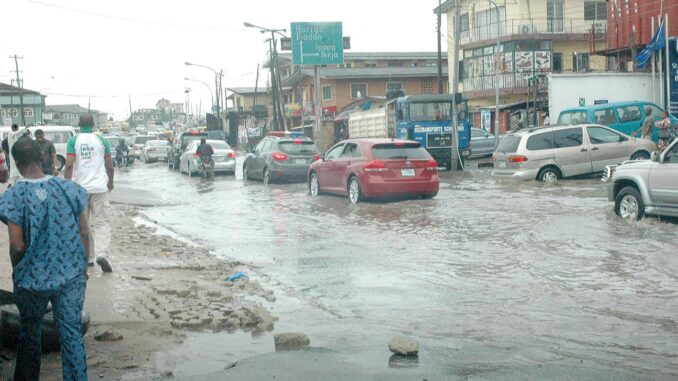
As the September annual rainfall peak season is expected to generate floods in parts of the country, it is worthwhile that Lagos State has issued flood alert for residents to take proactive measures to prevent loss of lives and property, damage to crucial infrastructure, disruption of socio-economic activities and even displacement of people in flood-prone areas. Already, a lot of residents have been hit by flood, which has disrupted their lives over the past months.
The other day, the Minister of Water Resources, Engr. Suleiman Adamu, released the 2020 Annual Flood Outlook (AFO) and new Flood Mobile App., a timely alarm that forewarns authorities and the citizenry to be prepared.
According to the Minister, at least 102 LGAs in 28 States fall within the highly probable flood risk areas, while parts of 275 LGAs in the 36 States of the federation, including FCT, fall within the moderate probable flood risk areas.
The States that are contiguous to Rivers Niger and Benue, namely Kebbi, Niger, Kwara, Adamawa, Taraba, Benue, Nasarawa, Kogi, Anambra, Delta, Edo, Rivers and Bayelsa states are likely to be affected by flooding. Coastal flooding is expected in Rivers, Cross River, Delta, Lagos, Ondo and Bayelsa states. Flash and urban floods are expected to occur in major cities across the country due to poor drainage system.
In the case of Lagos, residents of four local government areas, especially, those living on flood plains have been told to vacate their homes immediately.
The Commissioner for Environment and Water Resources, Tunji Bello, listed the councils that could witness high intensity rainfall between now and September as Lagos Mainland, Mushin, Ibeju-Lekki and Ikorodu. These local councils, he explained, have been identified as “highly probable flood risk in 2020.”
Quoting from the Annual Flood Outlook released by the Hydrological Services Agency, Bello identified 15 other local government areas that face risk and so, have been put on red alert to include Lagos Island, Alimosho, Amuwo-Odofin, Ikeja, Kosofe, Eti-Osa and Apapa.
The others are Ojo, Oshodi/Isolo, Agege, Ifako Ijaiye, Badagry, Surulere and Ajeromi-Ifelodun. Virtually, all parts of Lagos will face flood risk in the months ahead as the rains intensify.
Bello assured that his ministry would intensify on-going efforts at clearing silted drains as could be seen from the efforts of the Emergency Flood Abatement Gang (EFAG) all over the black spots in the state.
He advised residents to refrain from indiscriminate discharge of waste and patronising itinerant cart pushers. But cart pushers are patronised due to the inefficiency of garbage trucks that surface once in a while in residential neighbourhoods.
Therefore, the stage is set for another round of annual flood hazard. Both the government and the people should heed the warning, as ignoring it could be a death warrant. Nigeria experiences flooding annually. The 2012 and 2013 flood disasters were landmark experiences.
The recent flood disaster in Onitsha that pulled over 100 buildings with 20 people missing in the first week of June shows the extent to which the blind force of nature could wreak havoc. Past experiences should spur action to mitigate the disaster.
It is against this background that flood warnings are issued to sensitise people and the authorities on the need to prepare. Flooding occurs in Nigeria from a combination of heavy torrential downpour, ocean surge or the release of water from the Lagbo Dam in northern Cameroon. Each year, coastal communities and those on flood plains, especially, on the Niger/Benue trough bear the pains.
It is regrettable that despite the recurrence of annual events, few states have taken concrete measures to checkmate flood disasters. And not even the Federal Government has done much in that regard.
But Lagos too needs some introspection: whereas Lagos has always alerted residents on impending floods, it is pertinent to ask what the state government has done to mitigate flood risk. Every year, people suffer the same fate. Apart from the ad-hoc crude de-silting of drainage channels usually at the peak of the rainy season, which has not proved effective, what major flood control infrastructure has been put in place to mitigate disaster?
Recent downpours, which submerged Lekki Phases One and Two in Lagos, point to a bleak future, except appropriate protective dykes and embankments are erected to shield the areas from the ravages of the Atlantic Ocean.
The Lagos State Government had since 2017 been reported to have earmarked some N36 billion to tackle the menace of ocean surge by building 18 groynes (sea breakers), at intervals of 40 meters between Goshen Estate and Alpha Beach. What is the state of the projects? Has this worthy project been completed or abandoned?
Meanwhile, other state authorities along the Atlantic coastline should take cue from Lagos State by dreaming big first. The same measures should be extended inland by states bordering the Rivers Niger/Benue system. The federal government should collaborate with the states accordingly.
There should be public enlightenment, at the community level, to sensitise the public. Traditional rulers, council chairmen, community and youth leaders should rally to educate the people in their domain. They should ensure that blocked drainage channels are cleared. The flood warning should not be ignored to avoid unpleasant consequences.
But more important to is this: there is need to designate camps for the people who would be displaced by floods. Few states had taken proactive measures in this regard. That is unacceptable. All the affected states’ leaders should be humane enough to assist flood victims at this time. There should be migration from rhetoric to action.
END

Be the first to comment